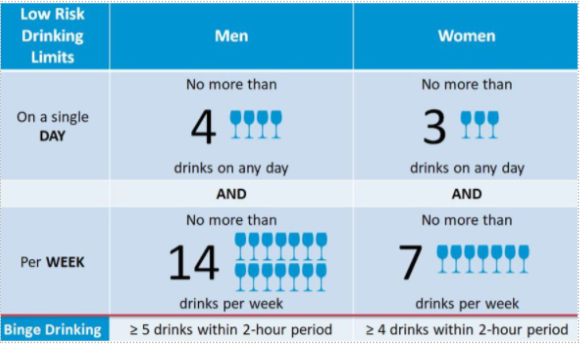Alcohol consumption has been part of American culture for generations. But what does the science say about alcohol consumption, and how does that compare to national government guidelines?
The Latest Science
The World Cancer Research Fund report on recommendations for cancer prevention concludes that there is ample evidence that alcohol causes many cancers including head and neck, colorectal, liver, and breast cancer after menopause.
The World Health Organization also states that there is no level of alcohol consumption that is without risk, as over 200 different diseases and conditions are affected by high-alcohol use. In January of 2023, the WHO made a broad statement that no level of alcohol consumption is safe when it comes to human health.
That stance is not unexpected given the rates of cancer, cardiovascular disease, stroke, motor vehicle injury, accidental death, and diabetes attributed to alcohol use.
The National Standards
National governments use the latest evidence to update their standards, but they are often not as progressive nor as timely as the science would support. Recently the Canadian guidelines were updated to recommend no more than two drinks a day. In the United States, the National Institute of Health defines “safe alcohol use” as no more than 4 drinks for men or 3 drinks for women on any day and no more than 14 or 7 drinks per week, respectively. This is much higher than what the WHO recommends. And yet, about 30% of U.S. adults exceed daily limits for alcohol at least once a year.

Image: ACLM Board Review Course 2020
High-Risk Drinking
There is agreement, however, that unsafe or high-risk alcohol consumption should be avoided completely. Unsafe drinking or high-risk drinking is any amount above moderation. That means having 2 glasses of wine a night and 3 on the weekend would constitute heavy alcohol use, as would drinking 5 beers during a football game.
Binge drinking also qualifies as heavy alcohol use. It’s defined as:
- Drinking enough so that blood alcohol levels reach 0.08mg/L or legal intoxication.
OR
- Consuming 5 drinks for men or 4 drinks for women within 2 hours at least once a month.
Why You Should Reconsider Your Alcohol Intake
Not only is any amount of alcohol potentially risky for cancer and many other chronic conditions, but generally the more often you drink, the more you’ll want. Science shows that chronic alcohol use results in needing more alcohol to achieve the same serotonin high, which means that as alcohol tolerance increases, there is less of an initial “happiness hit.” Consuming more alcohol also leads to a larger drop in serotonin when one comes down from the high, which is a very vicious cycle. Chronic alcohol use can also influence the stress response. This creates a sensation of more stress without alcohol and drives one to drink more frequently.
To Drink or Not to Drink
Ultimately, your choice to drink alcohol is up to you. But we encourage you to think about your alcohol use and how it measures up to the national standards in different countries and the WHO recommendations. The science shows that consuming less alcohol is better for preventing chronic disease, preserving brain health, and preventing the urge to drink more. If you feel you need help with reducing your alcohol intake or want to learn more about how alcohol affects you, consider joining one of our coaching programs for support, guidance, and resources.

